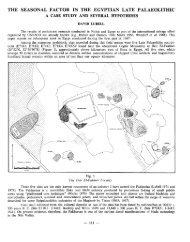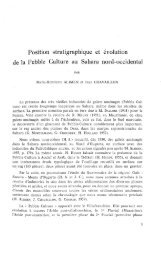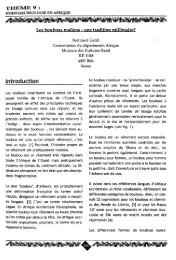Tichitt-Walata and the Middle Niger - PanAfrican Association of ...
Tichitt-Walata and the Middle Niger - PanAfrican Association of ...
Tichitt-Walata and the Middle Niger - PanAfrican Association of ...
You also want an ePaper? Increase the reach of your titles
YUMPU automatically turns print PDFs into web optimized ePapers that Google loves.
436 Kevin C. MacDonald<br />
fact remains <strong>the</strong> almost exclusive temper <strong>of</strong> <strong>the</strong> <strong>Tichitt</strong> tradition .throughout its long span <strong>of</strong> years,<br />
with s<strong>and</strong> <strong>and</strong> grog occasionally added or substituted. Everted rims, as well as red slip, only begin to<br />
appear in <strong>the</strong> Nkahl <strong>and</strong> Naghez phases (IV-V), with twisted twine remaining <strong>the</strong> dominant decor.<br />
By <strong>the</strong> Chebka <strong>and</strong> Arriane phases (VI-VII) everted rims have become common accounting for<br />
c.40-50% <strong>of</strong> all rims. Cord-wrapped stick motifs become common again, <strong>and</strong> start to be used as<br />
roulettes instead <strong>of</strong> only for impression (cf. Fig. 5 for ceramics from phases VI-VII). Finally, in <strong>the</strong><br />
AkJinjeir phase (VIII) applied plastic motifs become common, <strong>and</strong> vessels grow much larger <strong>and</strong><br />
have less decor.<br />
The <strong>Tichitt</strong> assemblages only become analogous with those· <strong>of</strong> Ndondi Tossokel'during <strong>the</strong><br />
Chebka <strong>and</strong> Arriane phases (e.g. higher proportions <strong>of</strong> everted rims, rouletted cord-wrapped decor,<br />
etc.). Their resemblance is not absolute, however, as some <strong>Tichitt</strong> vessels <strong>of</strong> <strong>the</strong>se phases feature<br />
knotted twine decor (cf. Hurley 1979: Type 165), a manipulation entirely absent in <strong>the</strong> Merna.<br />
Discussion: regional chronology<br />
Dating <strong>the</strong> Kobadi facies<br />
The earliest known date for <strong>the</strong> human occupation <strong>of</strong> <strong>the</strong> <strong>Middle</strong> <strong>Niger</strong> comes from <strong>the</strong> site <strong>of</strong> Tiabel<br />
Goudiodie. This site has been dated on freshwater oyster shells (E<strong>the</strong>ria elliptica) to between 2570<br />
<strong>and</strong> 2410 cal BC (Togola <strong>and</strong> Raimbault 1991). As usual with dates on freshwater materials, however,<br />
a carbonate reservoir effect <strong>of</strong> several hundred years should be allowed for, thus an initial<br />
occupation date <strong>of</strong> around 2000 BC is more likely for <strong>the</strong> site.<br />
It is difficult to know what <strong>the</strong> sequence <strong>of</strong> dates from <strong>the</strong> site <strong>of</strong> Kobadi actually date culturally,<br />
since all but one <strong>of</strong> <strong>the</strong>m are conventional collagen dates run on surface-collected bone, <strong>and</strong><br />
Ndondi Tossokel materials are known to also occur on <strong>the</strong> site (Raimbault <strong>and</strong> Dutour 1989,<br />
MacDonald 1994). The earliest date, 1740-1510 BC, was run on burned hippopotamus bone, <strong>and</strong> is<br />
thus most likely associated with <strong>the</strong> aquatically based Kobadi tradition. More recently, an as yet<br />
incompletely published date (Georgeon et al. 1992: 86) was run on an unspecified material from <strong>the</strong><br />
1989 excavations. Its result, 1740-1440 BC (3305±80 BP), is very close to that <strong>of</strong> <strong>the</strong> early 'hippo<br />
bone'. The middle dates are less certain, coming from indeterminate burned bone (1260-900 BC)<br />
<strong>and</strong> mammalian vertebrae (930-610 BC) respecti vely, <strong>the</strong> latter date coming from samples collected<br />
by Mauny in 1954 (Georgeon et at. 1992). The most recent date (770 to 380 BC) was run on <strong>the</strong><br />
cranium <strong>of</strong> a late inhumation recovered eroding from <strong>the</strong> midden surface. It is evident that we are<br />
dealing with a lengthy <strong>and</strong> probably multi-faceted occupation at Kobadi (c. 1750-400 BC). How<br />
punctuated this may have been by gaps in occupation, <strong>and</strong> <strong>the</strong> extent to which typical Kobadi wares<br />
continued throughout it, will only be clarified with <strong>the</strong> publication <strong>of</strong> a complete excavation report<br />
by Raimbault.<br />
A single radiocarbon date has recently been run on hippo ivory from <strong>the</strong> lowest Kobadi facies<br />
occupation layer <strong>of</strong> Kolima-Sud (layer V, KLS- l lv.25). The result <strong>of</strong> this apatite determination was<br />
as follows: 3365±70 BP11740-1530 cal BC (GX-21192-AMS). This date is comparable to <strong>the</strong> two<br />
earliest dates from Kobadi itself, <strong>and</strong> when bracketed by a date associated with Ndondi-Tossokel<br />
ceramics in <strong>the</strong> upper Kolima-Sud sequence (see below), suggests a minimum temporal range <strong>of</strong><br />
1750 to 1300 BC for <strong>the</strong> Kobadi facies.<br />
Dating <strong>the</strong> Ndondi Tossokel <strong>and</strong> Beretouma facies<br />
Test excavations carried out at <strong>the</strong> site <strong>of</strong> Kolima-Sud in 1990 provide our only definitive date for<br />
Ndondi Tossokel <strong>and</strong> Beretouma ceramics in context. There, two sondages revealed occupational<br />
deposits <strong>of</strong> 2.5 m in depth containing four principal occupational layers (MacDonald 1994). In





